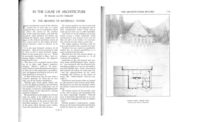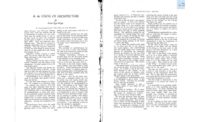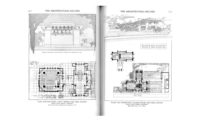From Architectural Record, October, 1927. Read a PDF of the original article here.
Time was when the hand wrought.
Time is here when the process fabricates instead. Why make the fabrication a lie or allow it to become one when we try to make it “beautiful”? Any such lie is an abuse of Imagination.
All Man has above the brute, worth having, is his because of Imagination. Imagination made the Gods – all of them he knows – it is the Divine in him and differentiates him from a mere reasoning animal into a God himself. A creative being is a God. There will never be too many Gods.
Reason and Will have been exalted by Philosophy and Science. Let us now do homage to Imagination.
We have suspected it and punished it and feared it long enough.
Imagination is so intimately related to sentient perception – we can not separate the two. Nor need do so.
Let us call Creative-Imagination the Man-light in Mankind to distinguish it from intellectual brilliance. It is strongest in the creative-artist. A sentient quality. To a degree all developed individuals have this quality, and to the extent that it takes concrete form in the human fabrications necessary or desirable to human life, it makes the fabrication live as a reflection of that Life any true Man loves as such – Spirit materialized.
The Machine is an obedient, tireless fabricator of a non-sentient product. A shaper and drawer of steel, a weaver of fabrics – “casting” forms continually in every material solvent by fire or water.
So the study of the process is as important as the study of the Machine. It is another phase of the Machine and in the method of the process too lies the opportunity for the artist. Unless he understands it what can he do with it – to qualify its product – from within? To modify it externally is not enough. He has been on the surface, as intimately related to its nature as a decalcomania on a tin box-cover is to the Nature of the thing going on inside. He has been a decorative label when he has been at all.
Let us, then, get inside.
We will find all the magic of ancient times magnified – Aladdin with his wonderful lamp had a poor thing relatively in that cave of his. Aladdin’s lamp was a symbol merely for Imagination. Let us take this lamp inside, in the Architect’s world.
Where begin? With mechanistic processes like weaving? Printing? Stamping? Or with casting? Or with plastic, chemicalized materials like concrete, plastering, steel making, glass making, paper making, ceramics?
One must serve for all. Then let us take one that is both a chemical-process and casting – concrete.
Concrete is a plastic material but sets so slowly as yet that moulds or so called “forms” are used to give it shape. It must be held, until it hardens sufficiently, to hold the shape desired.
Ordinarily in itself it has no texture unless the mould leaves it on the surface. It is, however, possible to use fine colored-gravel or crushed-marble or granite in the mixture so the superficial-cement (retarded in setting by some substance like soap applied to the interior surfaces of the “forms”) may be easily washed away, leaving the hard gleaming aggregate exposed in almost any color or texture.
All composite materials like concrete have possibilities of bringing out the nature of the mixture in some kind of surface treatment, and the materials may be variously composed in the substances mixed to secure these effects of texture and color desired in the finished product.
But, mainly, concrete is still a mass material taking form from moulds, erroneously called “forms.”
The materials of which the moulds themselves are made, will, therefore, modify the shape the concrete naturally takes, if indeed it does not wholly determine it.
Unity Temple at Oak Park was entirely cast in wooden boxes, ornamentation and all. The ornament was formed in the mass by taking blocks of wood of various shapes and sizes, combining them with strips of wood, and, where wanted, tacking them in position to the inside faces of the boxes.
The ornament partakes therefore of the nature of the whole, belongs to it. So the block and box is characteristic of the forms of this temple. The simple cubical masses are in themselves great concrete blocks.
The design makes a feature of this limitation as to form as they are grouped to express the great room within.
Here is a building, a monolith in mono-material, textured as described above, left complete as it came from the moulds – permanent architecture.
The whole is a great casting articulated in sections according to the masses of concrete that could safely be made to withstand changes of temperature in a severe climate.
It is a good record of this primitive period in the development of concrete building when it was necessary to pour the material into boxes to “set it” into shape.
It is a “natural building therefore, in a transition period of the development of the use of concrete.
I say a period of transition because concrete is essentially a plastic material, sometime to be used as such; used as a plastic material by plastering upon cores or upon steel fabrications. The resultant form may then take the shapes characteristic of drifted snow or sand or the smooth conformation of animals perhaps – as they become finished buildings.
But at the present time there comes a less cumbersome and a cheaper because less wasteful method than the moulds on a large scale that built Unity Temple. It was necessary then to build a rough building complete in wood as a “mould” into which the temple could be cast.
Now, in this easier more plastic method, standardization enters as the unit-system.
A unit-mass of concrete, size and shape determined by the work intended to be done and what weight a man can reasonably be expected to lift and set in a wall, is fixed upon. This in order to avoid the expensive larger moulds – say, the slab block we make 16-in. by 16-in. x 2 ½ in. thick.
Mechanical steel or aluminum moulds are made in which to precast the whole building in a small “unit” of that size. Grooves are provided in the edges of the slab-blocks so a lacing of continuous steel rods may be laid in the vertical and horizontal joints of the block slabs for tensile strength. The grooves are large as possible so they may be poured full of concrete after each course of blocks is set up, girding and locking the whole into one firm slab. Here ultimately we will have another monolith fabricated instead of poured into special wooden moulds. The moulds in this case are metal, good for many buildings, and take the impress of any detail in any scheme of pattern or texture imagination conceives. The whole building “precast” in a mould a man can life.
Here the making of the structural-unit and the process of fabrication become complete synchronized standardizations. A building for the first time in the world may be lightly fabricated, complete, of mono-material – literally woven into a pattern or design as was the oriental rug earlier referred to in “Standardization” fabrication as infinite in color, texture and variety as in that rug. A certain simple technique larger in organization but nor more complex in execution that that of the rug-weaving, builds the building. The diagrams and unit moulds are less simple. They have much study put on them, and organization becomes more than ever important.
When Machine-Standardizing enters, all must be accurate, precise, organized.
The Machine product can stand no slovenly administration for it can make no mistakes.
The limitations of both process and material are here very severe, but when these are understood and accepted we may “weave” an architecture at will – unlimited in quality and quantity except by the limitation of imagination.
Several mechanical moulds may be thrown into a Ford and taken where gravel and sand abound. Cement is all else needed, except a few tons of ¼ in. commercial steel bars, to complete a beautiful building. This – and an organization of workmen trained to do one thing well.
The ground is soon covered with slab-blocks, the block-stuff curing in moisture. After that, it is all a matter of reading the architect’s diagrams, which is what his plans now become. They are not tediously figured with haphazard dimensions any longer. They are laid out by counting blocks, corner blocks and half-blocks; so many blocks wide, so many high, and showing where specific blocks go is like counting stitches in the “woof” and threads in the “warp.” Building is a matter of taking slab-block stitches on a steel warp.







